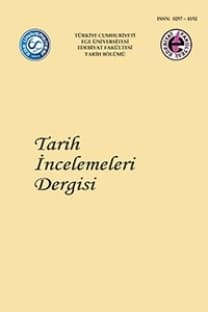Eski Yakındoğu’da Yılanlı Tanrıça Kültü Üzerine Bir Değerlendirme
Eski Yakındoğu toplumlarında yer altı güçleri ile
bağlantılı olarak dünyada gizli kalmış özlerin ve minerallerin bilgisine sahip
bir varlık şeklinde düşünülen yılan, aynı zamanda Prehistorik dönemlerden
itibaren mevsimsel döngü ve yeniden dirim ile ilişkilendirilmiştir. Yılanın
ilişki içerisinde olduğu tanrısal güçler merkezi yapıların doğuşu ile birlikte
farklılıklar göstermeye başlamıştır. Zirai faaliyetler, sulama sistemleri,
tahıl ambarları, bitkiler ve şifa ile ilişkili güçlerle bağlantılı olan yılan
sembolü kimi zaman kompozit bir varlık olarak gerek arkeolojik belgelerde
gerekse çivi yazılı metinlerde karşımıza çıkmaktadır. Yılanlı tanrıça
sembolleri Neolitik döneme kadar gitmektedir. Muhtemelen ilkel toplumlar,
doğadaki ölüm ve yeniden dirim ile ilgili güçlerin kontrolünün bir tanrıça
tarafından yürütüldüğünü düşünmekteydi. Anadolu’da M.Ö. II. binde yer altı
tanrıçalarına ilişkin bilgileri Hititçe çivi yazılı belgelerden öğrenmekteyiz.
Buna göre, yer altı ile ilişkili tanrıçaların çoğu kader ve nehir kıyısının
tanrıçaları olarak betimlenmişlerdir. Bu tanrıçaların, uzun hayat ve şifa verme
yetileri bulunmaktadır. Harput Kabartması üzerinde görülen ve belden aşağısı
yılan sarmalı şeklinde tasvir edilen yılanlı tanrıça, Eski Babil döneminde
ortaya çıkan ve Mısır sanatı özellikleri taşıyan, Suriye orijinli bir yer altı
tanrıçası olmalıdır. Ayrıca, Harput Kabartması üzerindeki yılanlı tanrıça
savaşın kaderinin belirlenmesinde etkin bir role sahip görünmektedir.
Anahtar Kelimeler:
Harput Kabartması, Yılanlı Tanrıça, Yeniden Dirim, Yer Altı Tanrıçaları
An Evaluation on the Cult of the Snake Goddess in the Ancient Near East
Serpent, which was
believed to possess the information on the minerals and hidden sources within
the earth in relation to the underground forces in the Ancient Near East
societies, was also associated with the seasonal cycle and resurrection since
the Prehistoric Periods. Associated with the serpent, the divine forces
displayed differences with the dawn of the central structures. The symbol of
the serpent, associated with the agricultural activities, irrigation systems, granaries,
vegetables and healing, sometimes confronts us both in the archaeological
documents and cuneiform scripts as a composite creature. The symbols of serpent
goddess date back to the Neolithic Period. Probably the primitive civilizations
thought that the forces of death and resurrection in nature were performed
under the control of a goddess. In Anatolia of the 2nd millennium
B.C., we are learning the information about the underworld goddesses from the
Hittite cuneiform scripts. Accordingly, most of the goddesses, related to the
underworld, were defined as the goddesses of fate and river banks. These
goddesses have the abilities to grant long life and cure. The serpent goddess,
displayed on the Harput Relief and described to have a serpent body below her
waist, must be an underworld goddess, who appeared in the Ancient Babylon
Period as she carried the characteristics of the Egyptian art, and originated
from Syria. Furthermore, the serpent goddess, on the Harput Relief, seems to
have an important role in determining the result of the war.
Keywords:
Harput Relief, Snake Goddess, Rebirth, Netherworld Goddesses,
___
- Akkermans ve Schwatrz 2003 Peter M.M.G. Akkermans, Glenn M. Schwartz, The Archaeology of Syria: From Complex Hunter-Gatherers to Early Urban Societies (c. 16.000-300 BC), Cambridge University Press, Cambridge. Archi 2013 Alfonso Archi, “The Anatolian Fate-Goddess and their Different Traditions”, Eva Cancik-Kirschbaum, Jörg Klinger and Gerfrid G.W. Müller (eds), Diversity and Standardization: Perspectives on Social and Political Norms in the Ancient Near East, Berlin, Akademia Verlag, s.1-26 Aruz 1999 Joan Aruz, “Images of the Supernatural World: Bacrtia Margiana Seals and Relations with the Near East and the Indus Valley”, Ancient Civilizations from Scythia to Siberia 5 / 3, s.12-30. Azarpay 1991 Guitty, Azarpay “The Snake-Man in the Art of Bronze Age Bactria”, Bulletin of the Asia Institute 5, s. 1-10. Benz ve Bauer 2013 Marion Benz, Joachim Bauer, Joachim, “Symbols of Power – Symbols of Crisis? A Psycho-Social Approach to Early Neolithic Symbol Systems” Neo-Lithics 2/13: The Newsletter of Southwest Asian Neolithic Research Special Topic on the Symbolic Construction of Community, s.11-24. Brayn 2015 Betsy M., Brayn, “Portraiture” A Companion to Ancient Egyptian Art (ed. Melinda K. Hartwig), Wiley Blackwell, s.375-396. Buchanan 1971 Briggs Buchanan “A Snake Goddess and Her Companions a Problem in the Iconography of the Early Second Millennium B.C.” Iraq 33/1, s.1-18. van Buren 1934 E. Douglas van Buren, “The God Ningizzida”, Iraq I / 1, s.60-89. van Buren 1935-36 E. Douglas van Buren, “Entwined Serpents”, Archiv für Orientforschung, 10 Bd., Berlin, s.53-65.
- ISSN: 0257-4152
- Başlangıç: 1983
- Yayıncı: Prof. Dr. Süleyman Özkan
Sayıdaki Diğer Makaleler
Beyaz Rus Mültecilerinin Gözünden Milli Mücadele ve Ankara Hükümeti İle Olan İlişkileri
Power, Politics and Tradition in the Mongol Empire and the Īlkhānate of Iran
Eski Yakındoğu’da Yılanlı Tanrıça Kültü Üzerine Bir Değerlendirme
Eritre ve Etiyopya Arasındaki Danakil Bölgesinde Osmanlı Hâkimiyeti ve Kaymakam Pertev Efendi
Effects of the Decisions of San Remo Conference on Syria and Iraq
Pergamon’un Yolları: Antikçağ’dan Bizans’a Bakırçay (Kaikos) Havzası’nın Yol Sistemi
